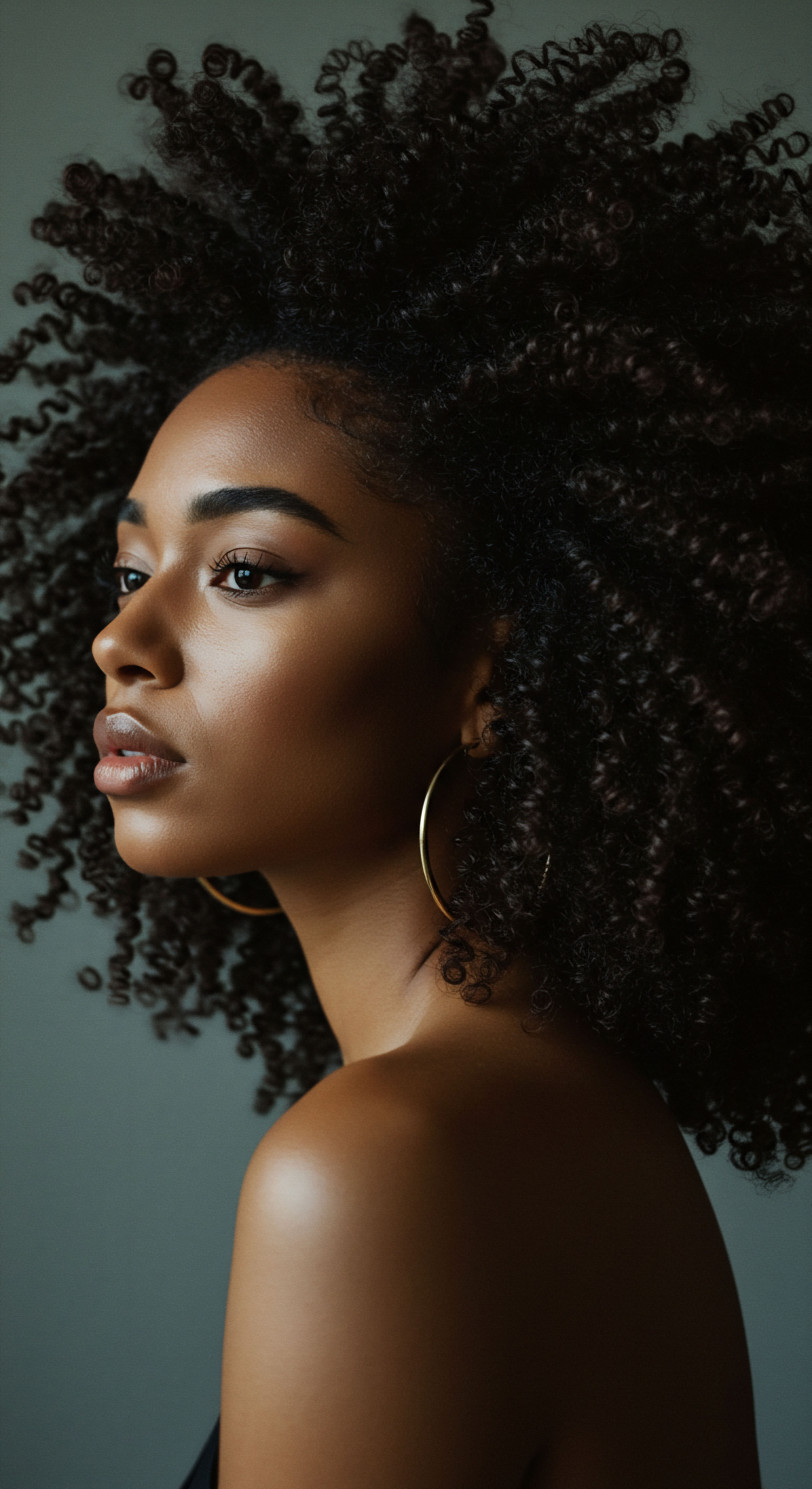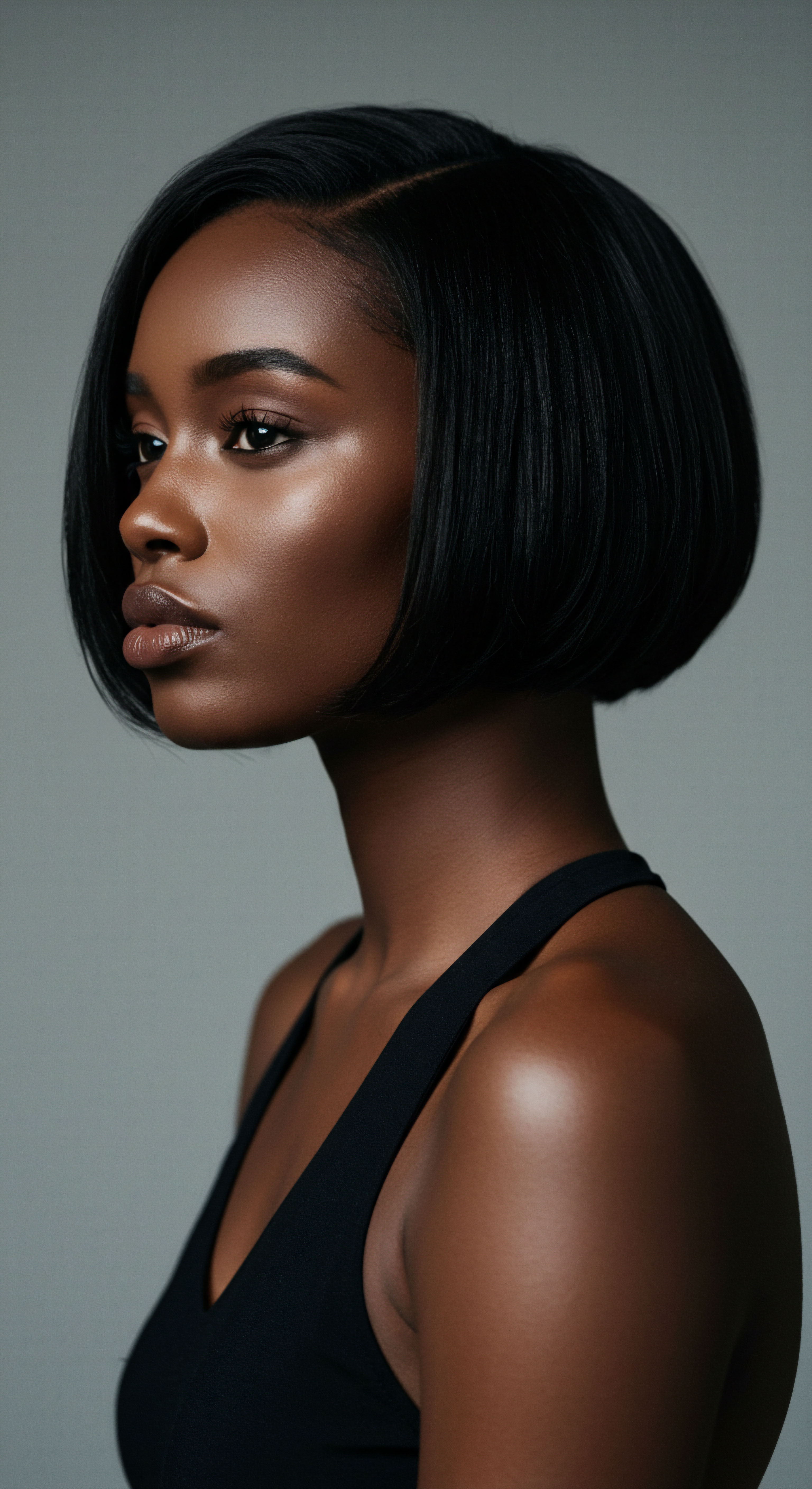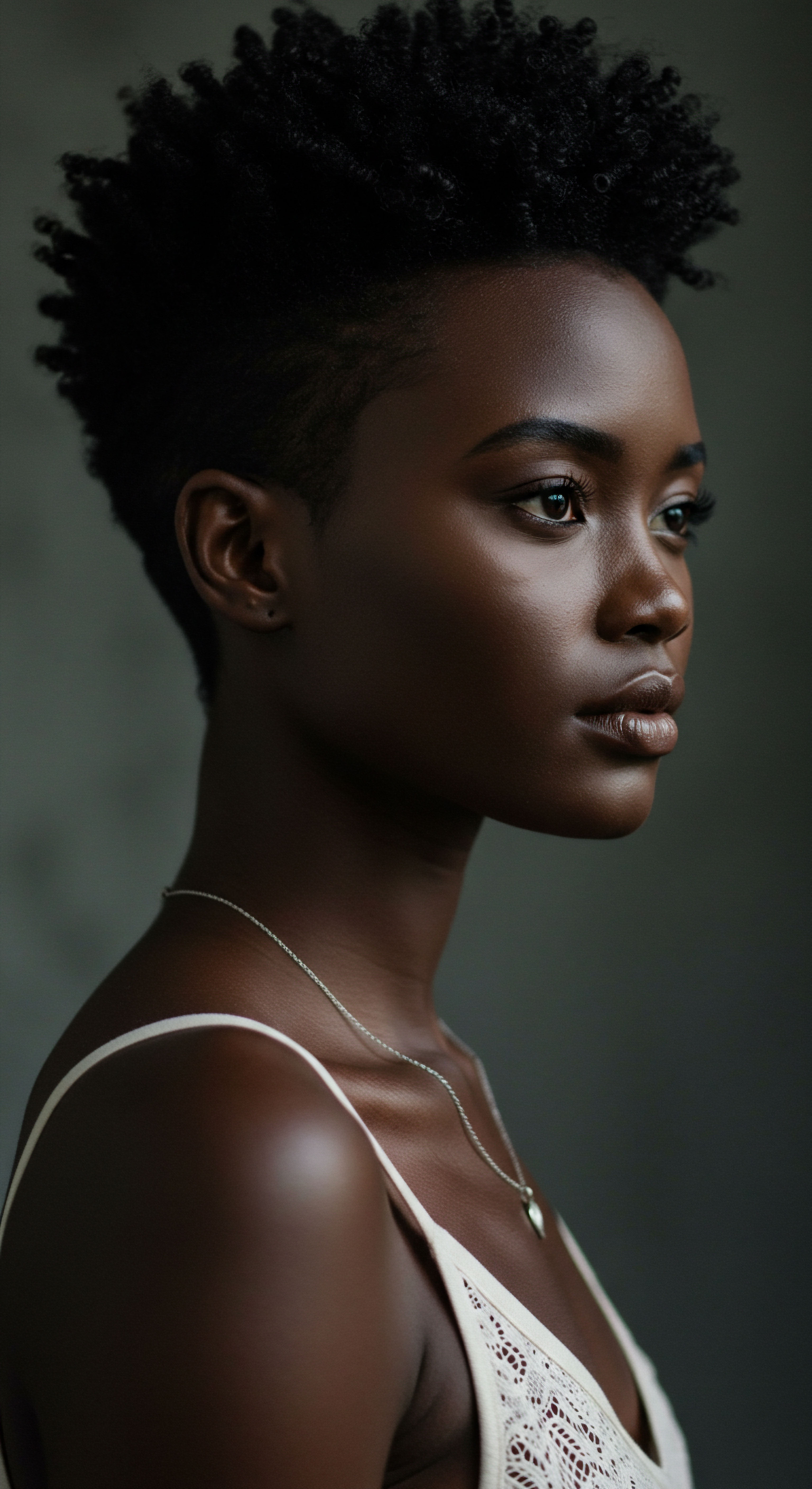
Roots
There exists a quiet language within our strands, a whisper of stories told not through words, but through texture, resilience, and even vulnerability. Our hair, a living extension of ourselves, often mirrors the unseen currents of our inner world. When life’s pressures mount, when the spirit feels burdened, these echoes can manifest in tangible ways, altering the very nature of our textured hair. To truly grasp how the subtle yet insistent weight of stress influences our coils and kinks, we must first descend to the fundamental architecture of hair itself, understanding its origins and the delicate systems that govern its vibrant life.

The Hair Follicle a Microcosm of Life
Each strand of hair begins its journey deep within the scalp, housed in a remarkable structure called the Hair Follicle. This tiny organ, a marvel of biological engineering, is not merely a passive anchor; it is a dynamic hub of cellular activity, constantly growing, resting, and renewing. The follicle’s health directly dictates the quality, strength, and even the appearance of the hair it produces.
For textured hair, the follicle’s unique curvature shapes the strand’s distinct curl pattern, influencing everything from its natural volume to its inherent susceptibility to certain external pressures. Any disruption at this foundational level can reverberate through the entire hair fiber.
The dermal papilla, nestled at the follicle’s base, acts as its command center. This richly vascularized structure provides the essential nutrients and oxygen required for rapid cell growth within the hair bulb. It also contains hormone receptors, which are instrumental in regulating the hair growth cycle.
When the body experiences stress, this intricate system faces an immediate challenge. Hormones, particularly cortisol, surge, and these elevated levels can directly interfere with the dermal papilla’s signaling, potentially disrupting the natural cycle of hair development.

Hair’s Delicate Growth Cycle
Hair growth proceeds through a predictable sequence of phases ❉ anagen, catagen, and telogen. The Anagen Phase is the period of active growth, where cells divide rapidly, pushing the hair shaft upwards. This phase can last for several years, determining the maximum length a hair can achieve.
Following this is the brief Catagen Phase, a transitional period where growth ceases and the follicle shrinks. Finally, the hair enters the Telogen Phase, a resting period before the old hair sheds and a new anagen hair begins to grow in its place.
Stress can disrupt the hair growth cycle, pushing actively growing hairs into a premature resting phase, leading to noticeable shedding.
Under ordinary circumstances, about 85% of scalp hairs are in the active anagen phase, while approximately 15% are in the resting telogen phase. However, when the body perceives significant stress, this delicate balance can shift dramatically. The stress response system, prioritizing vital functions, can redirect resources, leading to a premature shift of a greater proportion of hair follicles from the anagen to the telogen phase. This phenomenon, known as Telogen Effluvium, results in sudden, widespread shedding, often noticed two to three months following a significant stressful event.

Oxidative Stress and Follicle Integrity
Beyond hormonal disruptions, stress also contributes to oxidative stress within the body. This imbalance, where cell-damaging free radicals outnumber protective antioxidants, can directly impact the health and strength of hair follicles. Oxidative stress can hinder pre-emergent hair growth and negatively affect the scalp environment, making it less conducive to healthy hair production.
The internal morphology of textured hair, with its unique curl patterns, also means it faces particular mechanical stresses during daily care. These inherent characteristics, combined with the biochemical changes induced by stress, can lead to increased fragility. The hair shaft, which is the visible part of the hair, becomes more vulnerable to damage, manifesting as increased breakage and a noticeable alteration in its typical feel and appearance.
| Phase Anagen (Growth) |
| Description Active cellular division, hair grows from follicle. Longest phase. |
| Stress Influence Shortened, leading to fewer long hairs. |
| Phase Catagen (Transition) |
| Description Growth ceases, follicle shrinks. Brief phase. |
| Stress Influence Premature induction, accelerating shift to resting. |
| Phase Telogen (Resting) |
| Description Hair rests before shedding, new hair forms below. |
| Stress Influence Increased proportion of hairs enter this phase, causing shedding. |
| Phase Understanding these phases helps illuminate how stress directly interrupts the natural life cycle of each hair strand. |

What are the Fundamental Elements of Hair Structure That Stress can Compromise?
The foundational elements of hair structure, particularly in textured hair, are remarkably sensitive to internal shifts. Stress can compromise the Cuticle Layers, the protective outer scales that lie flat on healthy hair, giving it shine and smoothness. When stressed, these cuticles can lift, leading to a rougher feel, increased tangling, and a greater susceptibility to external damage. The Cortex, the hair’s inner core responsible for its strength and elasticity, can also suffer.
Nutrient redirection and hormonal imbalances, a direct result of chronic stress, can weaken the protein bonds within the cortex, making the hair more prone to breakage and less resilient to styling. Even the Medulla, the innermost layer found in some hair types, might be indirectly affected as overall hair health declines. These microscopic changes accumulate, contributing to a visible decline in hair quality and manageability.

Ritual
The journey of textured hair care is often a conscious, deeply personal practice, a series of gentle acts performed with intention. These rituals, from the careful detangling to the nourishing application of balms, become a rhythm, a connection to our strands. Yet, when the unseen weight of stress settles upon us, even these comforting routines can feel altered, or worse, neglected. Understanding this interplay, between our inner state and our outward acts of care, allows us to adapt our practices, transforming them into a resilient shield against stress’s subtle incursions.

How does Stress Impact Daily Hair Care Practices and Product Efficacy?
Stress casts a long shadow, influencing not only the biological mechanisms of hair growth but also our very engagement with self-care. When feeling overwhelmed, the meticulous, time-consuming aspects of textured hair care might seem like an insurmountable task. This leads to reduced attention to detail, skipped steps, or even a complete abandonment of established routines. Such neglect can quickly exacerbate existing issues, turning minor dryness into significant breakage or a healthy scalp into an irritated, flaky environment.
Moreover, stress can indirectly affect how our hair responds to products. Nutritional deficiencies, often a side effect of stress-related eating habits or reduced appetite, can impact the scalp’s sebum production and overall hair health. A stressed body might not properly absorb essential nutrients, even if they are present in the diet, leaving hair follicles deprived of the building blocks they need to thrive. This means that even the most thoughtfully chosen conditioners or serums might not deliver their full benefits to hair that is already compromised from within.

Adapting Cleansing and Conditioning for Stressed Strands
When textured hair is under stress, it often signals its distress through increased dryness, brittleness, and a rougher feel. The conventional wisdom of washing hair two or three times a week remains, but the approach requires greater gentleness and intentionality. Choosing sulfate-free, hydrating cleansers becomes paramount, as harsh detergents can strip the hair of its already diminished natural oils, further compromising its delicate moisture balance.
Adjusting cleansing routines and product choices can help mitigate the physical manifestations of stress on textured hair.
Deep conditioning treatments, previously a weekly indulgence, may need to become a more frequent, non-negotiable step. These treatments infuse moisture and fortify the hair shaft, offering a protective barrier against external aggressors and the internal vulnerabilities induced by stress. Consider incorporating protein treatments judiciously, as they can strengthen the hair shaft and reduce breakage, particularly when hair feels weak or excessively shed. However, too much protein can lead to stiffness, so a balanced approach is always key.
- Gentle Cleansing ❉ Opt for Sulfate-Free Shampoos that cleanse without stripping natural oils, especially important for textured hair which tends to be drier.
- Intense Hydration ❉ Prioritize Deep Conditioners and leave-in treatments to replenish moisture lost due to stress-induced dryness.
- Mindful Detangling ❉ Use a Wide-Tooth Comb or fingers on wet, conditioned hair to minimize breakage, which is more prevalent when hair is stressed.

Protective Styles and Scalp Care as Sanctuaries
Protective styling, a cornerstone of textured hair care, takes on an even greater significance during periods of stress. Styles that minimize manipulation and tension, such as braids, twists, or buns, can reduce the physical stress on hair follicles and shafts, thereby mitigating breakage. This practice not only safeguards the hair but also offers a psychological reprieve, simplifying daily routines and freeing up mental energy that might otherwise be consumed by hair concerns.
Scalp health, often overlooked, becomes particularly crucial when stress is present. Chronic stress can disrupt the scalp’s delicate pH balance, impair its protective barrier, and even affect nutrient absorption directly at the follicle level. This can manifest as increased shedding, sensitivity, tenderness, or even sudden appearances of dandruff or flaking.
Regular, gentle scalp care, including massages to improve circulation and stimulate follicles, can help to counteract these effects. Exfoliating scalp treatments can remove buildup and promote a healthier environment for growth.
| Area of Care Cleansing |
| Common Stress Impact Dryness, increased fragility |
| Ritual Adaptation Use moisturizing, sulfate-free cleansers less frequently. |
| Area of Care Conditioning |
| Common Stress Impact Brittleness, lack of shine |
| Ritual Adaptation Increase frequency of deep conditioning and leave-in treatments. |
| Area of Care Styling |
| Common Stress Impact Increased breakage, shedding |
| Ritual Adaptation Prioritize low-manipulation, protective styles. |
| Area of Care Scalp Health |
| Common Stress Impact Itchiness, flaking, sensitivity |
| Ritual Adaptation Incorporate regular, gentle scalp massages and targeted treatments. |
| Area of Care By consciously adjusting our hair care rituals, we offer our strands a sanctuary amidst life's pressures. |

Relay
The story of our hair, particularly textured hair, is never simply a biological one. It is a profound chronicle interwoven with culture, identity, and the intricate landscape of our emotional and psychological lives. When we speak of stress affecting textured hair, we are not merely discussing a physiological response; we are addressing a complex interplay where societal pressures, historical context, and individual well-being converge, creating a uniquely layered experience. This deeper conversation requires us to look beyond the visible, to understand the unseen forces that shape our strands and our spirit.

What are the Deeper Psychological and Cultural Stressors That Uniquely Impact Textured Hair Health?
For individuals with textured hair, particularly those from Black and mixed-race communities, the experience of stress often extends beyond universal daily pressures. Societal beauty standards, historically rooted in Eurocentric ideals, have long positioned natural textured hair as “unprofessional,” “messy,” or “unruly.” These pervasive messages, encountered in schools, workplaces, and media, contribute to a chronic, subtle, yet potent form of psychological stress.
This persistent external judgment can lead to significant internal conflict and anxiety. Individuals may feel compelled to alter their natural hair through chemical straightening or excessive heat styling to conform, a process that can be physically damaging to the hair and psychologically taxing. The mental toll of such experiences is substantial, manifesting as internalized negative self-perception, hypervigilance about how one’s hair is perceived, and chronic stress in academic or professional settings.
A striking illustration of this cultural pressure, with direct implications for hair health and overall well-being, is found in research highlighting how lifestyle choices are constrained by hair care concerns. Studies show that 45% of Women with Textured Hair Avoid Physical Exercise to Preserve Their Hairstyles. This creates a challenging cycle ❉ exercise is a recognized stress-management technique, yet the societal pressure to maintain a certain hair appearance, often achieved through time-consuming or fragile styles, actively deters a significant portion of the textured hair community from engaging in this crucial activity. This is not a mere preference; it is a forced compromise between mental health and hair presentation, underscoring a systemic barrier to holistic wellness.

The Autoimmune Connection
The body’s stress response, particularly chronic elevation of cortisol, directly influences the immune system. This connection becomes particularly relevant when considering autoimmune hair loss conditions. Alopecia Areata, an autoimmune disorder where the immune system mistakenly attacks hair follicles, can be triggered or exacerbated by psychological stress.
While a genetic predisposition often plays a part, stressful life events can act as a catalyst, initiating or worsening patchy hair loss. The emotional distress resulting from hair loss itself can then create a vicious feedback loop, leading to further stress and potentially more hair loss.
The intricate dance between stress hormones and immune responses can significantly impact the onset and progression of autoimmune hair loss conditions.
For textured hair, conditions like Central Centrifugal Cicatricial Alopecia (CCCA), which predominantly affects women of African descent, are also influenced by chronic stress, though the exact causal link is still under investigation. While CCCA is distinct from alopecia areata, the systemic inflammation and immune dysregulation associated with prolonged stress can contribute to the vulnerability of hair follicles, potentially aggravating such conditions or hindering recovery.

The Behavioral Manifestations of Stress
Beyond direct physiological and immunological impacts, stress can also manifest in behavioral patterns that harm textured hair. One such condition is Trichotillomania, a disorder characterized by repetitive hair pulling. While complex in its origins, stress, anxiety, and frustration are commonly reported triggers.
For some individuals with trichotillomania, there is a specific tactile sensation associated with pulling, often targeting hairs perceived as “different” in length or texture. This can unfortunately include the naturally varied textures within a single head of coiled or kinky hair, leading to a self-perpetuating cycle of pulling and subsequent damage.
Moreover, chronic stress can lead to less visible behavioral changes, such as poor dietary choices or inadequate sleep, both of which indirectly compromise hair health. When the body is under strain, it diverts essential nutrients to vital organs, leaving hair as a lower priority. This nutritional deficit, combined with disturbed sleep patterns that affect cortisol regulation, further weakens hair strands and impedes healthy growth, creating a holistic challenge to hair vitality.

Societal Pressures and Hair Health Disparities
The intersection of stress, mental well-being, and textured hair is particularly acute within the context of racial and social discrimination. Research highlights that for Black women, anxiety is often more chronic and its symptoms more intense compared to their white counterparts. This heightened baseline of stress, often due to systemic biases and microaggressions related to hair, can create a predisposition to hair issues. The pressure to conform, coupled with the emotional and psychological impact of hair loss, can lead to a negative feedback loop, affecting both mental and hair health.
The societal value placed on certain hair types can also affect how individuals seek and receive care. Many medical professionals may lack familiarity with textured hair care practices, leading to unhelpful or even harmful advice. This highlights the critical need for culturally informed approaches to hair health, acknowledging that stress on textured hair is not solely a biological phenomenon, but a deeply personal and often culturally-charged experience.

Reflection
As we consider the profound relationship between our inner landscape of stress and the outer manifestation in our textured hair, a clear understanding emerges ❉ hair health is a testament to our holistic well-being. The strands we wear are not merely fibers; they are living extensions of our personal story, carrying the imprints of our physiological responses, our daily rhythms, and the broader cultural narratives that shape our lives. To nurture textured hair through periods of stress requires more than surface-level solutions; it demands a compassionate, informed approach that acknowledges the intricate connections between mind, body, and spirit.
It is a call to listen to our hair’s subtle cues, to understand its unique language, and to honor its inherent beauty and resilience, even when life’s currents run strong. This journey of understanding and care is, in essence, a profound act of self-reverence.

References
- Forhair. “Can Stress Change Your Hair Texture? Exploring the Connection.” 2023.
- Aedit.com. “The Impact Of Stress On The Hair.” 2021.
- AHS India. “How is the Immune System Related to Hair Growth.” 2024.
- DrOmics Labs. “The Genetics of Hair Follicle Sensitivity ❉ Understanding the Role of Genetics in Hair Loss.” 2024.
- I2CAN – iican. “How to Identify and Treat Different Types of Hair Damage.” 2024.
- Head Spa Toronto. “Stress & Your Scalp ❉ Head Spa Solutions for Hair Health.” 2025.
- TrichStop.com. “Tactile Sensations and Hair Pulling ❉ Strategies for Managing the Urges.” 2025.
- Bounce Black. “Hair and Mental Health.”
- CLOUD NINE. “How Hormones Affect Your Hair.”
- “How to Combat Stress and Hair Loss in Natural Textures ❉ A Comprehensive Guide.” 2024.
- Davines. “Why Your Hair Texture Changes and What To Do About It.”
- Little Extra. “6 Types of Hair Damage & How to Avoid It.” 2023.
- Dr Cinik. “Hair Follicles ❉ Definition, Diseases and Treatments.”
- Newsweek. “Signs Stress Is Damaging Your Hair, From a Beauty Expert.” 2023.
- Research. “Beyond the roots ❉ exploring the link between black hair and mental health.” 2025.
- Black Beauty & Hair. “Scalp Health and Hair Growth ❉ Essential Tips for Strong Hair.”
- Cosmetics & Toiletries. “Defying Damage ❉ Understanding Breakage in Afro-textured Hair.” 2020.
- Halo Haircare Society. “Trichotillomania ❉ Tips, Triggers, and Tools to Help You Find Relief.” 2024.
- English Dermatology. “Stress and Your Tresses – How to Keep Your Hair Healthy When You’re Feeling the Pressure.” 2023.
- Everyday Health. “7 Things Your Hair Says About Your Health.”
- DermNet. “Trichotillomania.”
- DermNet. “Psychological effects of hair loss.”
- Philip Kingsley. “How does stress affect your hair?” 2019.
- WebMD. “Trichotillomania ❉ Causes, Symptoms, and Treatment.” 2023.
- ResearchGate. “Psychological Aspects of Hair Disorders ❉ Consideration for Dermatologists, Cosmetologists, Aesthetic, and Plastic Surgeons.” 2021.
- PMC. “Trichotillomania ❉ What Do We Know So Far?”
- Consensus ❉ AI Search Engine for Research. “Alopecia Areata ❉ Symptoms and Causes.”
- Tru-Skin Dermatology. “The Connection Between Autoimmune Diseases and Alopecia.”
- “How Stress Causes African American Hair Loss and Depression ❉ Tips for.” 2024.
- ResearchGate. “Insights into Alopecia Areata ❉ A Systematic Review of Prevalence, Pathogenesis, and Psychological Consequences.” 2024.
- Bosley. “Can Stress Cause Temporary Hair Loss, or Telogen Effluvium?”
- ““Hair is your crown and glory” – Black women’s experiences of living with alopecia and the role of social support.”
- Karger Publishers. “Psychological Aspects of Hair Disorders ❉ Consideration for Dermatologists, Cosmetologists, Aesthetic, and Plastic Surgeons.” 2021.
- MSD Manual Consumer Version. “Alopecia (Hair Loss) – Skin Disorders.”
- PMC – PubMed Central. “Psychological Aspects of Hair Disorders ❉ Consideration for Dermatologists, Cosmetologists, Aesthetic, and Plastic Surgeons.” 2021.
- Modern Salon. “Stress Induced Hair Loss? Black Women Are Among the Most Vulnerable.” 2021.
- BPS – British Psychological Society. “Afro hair and mental health.” 2022.
- ResearchGate. “Alopecia Areata’s Psychological Impact on Quality of Life, Mental Health, and Work Productivity ❉ A Scoping Review.” 2024.
- ResearchGate. “Psychological Aspects of Hair Disorders ❉ Consideration for Dermatologists, Cosmetologists, Aesthetic, and Plastic Surgeons.” 2021.
- NCBI Bookshelf. “Telogen Effluvium – StatPearls.” 2024.
- PsychoHairapy. “Sis, It’s Not You, It’s Life ❉ Stress and Hair Loss.” 2022.
- PMC. “The Person Beneath the Hair ❉ Hair Discrimination, Health, and Well-Being.” 2023.
- The Institute of Trichologists. “Research.”
- American Academy of Dermatology. “Hair loss in Black women ❉ Here’s how dermatologists help.” 2025.
- Johns Hopkins Medicine. “Hair Loss in Black Women ❉ Tips from an Expert.”